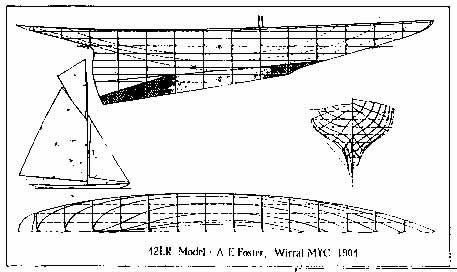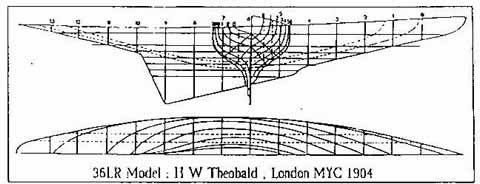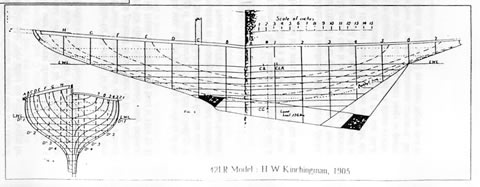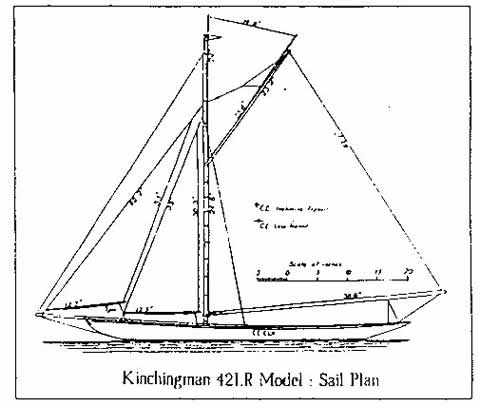|
Though many modellers persisted with the 10-rater when
full size sailors abandoned the Length and Sail Area Rule, there was a minority
who attached greater importance to keeping in step with full size practice
and followed the change to the LRR. The aim of the Rule in the full size sport
was to produce boats that would have a form suitable for the provision of
accommodation and thus a continuing life as cruisers after they became outdated
as racing craft. The method was to introduce a complex formula,
| Rating in feet = |
L + B + 0.75G + 0.5 sqrt S
|
| |
|
| |
2
|
L is lwl,
B is extreme beam
G is a skin girth, waterline to waterline, taken at 60% of lwl
S is sail area
The aim of the girth measurement was to penalise skimming
dish and fin and bulb forms, but it was not very successful. Many designers
persisted with the forms they had produced under the LSA Rule and accepted
the penalties. They were able to do this because the Sail area element in
the formula was taxed much less severely than under the LSA Rule. Despite
intending to introduce scantling regulations the YRA failed to get a system
agreed in time and the Rule produced boats that were very lightly built, over-canvassed
and in many respects unsatisfactory. So much so, that the YRA had a second
go after only five years experience.
| Rating in feet = |
L + B + 0.75G + 4d + 0.5 sqrt S
|
| |
|
| |
2.1
|
lwl,
B is extreme beam
G is a chain girth, waterline to waterline, taken at 60% of lwl
d is the difference between skin girth and chain girth at 60% of the lwl
S is sail area
The new formula was essentially the same, but introduced a new element, 'little
d', which was the difference between skin girth and a chain girth at the 60%
station. As this measurement was multiplied by 4, its effect on rating was
severe. 'Big G' was retained, but was now a chain girth measurement, intended
to place restrictions on hull depth without requiring a direct measurement
of draft. There were still no scantling Rules and the boats were extremely
lightly built and short lived. The Yachtsman was scathing.
They were predicted to be more compact, more seaworthy,
more comfortable and less expensive than the old boats. In practice they have
proved to be over canvassed, wet, hard to steer, expensive to build and maintain,
tender and thus poor turning to windward. They are lightly built and their
hulls are easily strained. Their rigs are big and vulnerable, but owners would
rather see racing postponed or abandoned than reef.
The effect was still clearly not what the Rule makers
said they wanted. One anguished correspondent complained that 'There is no
Rule that will dry bedding soaked through gaping seams'. In the season of
its introduction there were almost no 'First Class' yachts in commission and
in 1904 there were none. More importantly four wealthy owners built yachts
as fast cruisers, not to YRA rule and following Lloyds Register Yacht scantlings.
(An extended treatment of the development of full size
Rules in the late 19th century can be found in Russell Potts The Social Construction
of a Sporting Technology 1880-1920, available from the Curved Air Press.)
Modellers seem to have been slow in adopting the
first LRR and the only evidence we have is of some speculative designs for
full size design competitions drawn by men who we know to have been active
as modellers.
 |
|
Illustration 1: Odgers 42LR Fast Cruiser 1898.
There is no evidence of any models designed or built to the 1st LRR
|
.
By the time of the 2nd LRR, those clubs with an attachment keeping is step
with to full size Rules, notably the London, with a large element of owners
of full size craft, and the Wirral, with a substantial membership drawn from
the design office of the Cammell Laird shipyard, had adopted the 2nd LRR and
built 42 foot LR boats at one inch to the foot. The 36LR design by H Wilson
Theobald is apparently an aberration and it is not known that any races were
ever offered for this size of model.
The designs had a clear family likeness to the full size boats designed under
the Rule, though in acknowledgement of the 'square-cube' law, they tended
to have more of their rating in the hull and less in the sail area. Even so,
and allowing for the compensating effect of sailing on inland waters and for
the effect of the wind gradient in tempering the force of the wind to models,
like many LSA Rule models, they were over-canvassed and must have done a lot
of their sailing in rigs smaller than their top suit. The effect of the '4d'
element in the formula can be seen in the very full body forms and relatively
small fin element in the body sections, as can the requirement that the draft
should not decrease aft of the girth measurement point, which produced a characteristic
'hook' in the profile,. The rigs seem all to have been closely modelled on
full size cutter practice. No models built to this Rule and very few designs
are known to have survived

Illustration 3, Foster 42LR

Illustration 4, Theobald 36LR

Illustrations 5 and 6, Kinchingman
42LR.

Addendum - June 2011, since the above was written, the model pictured below has come to light, it could be a surviving 42LR. Having a guess at the waterline and sail area etc, it works out very close to 42LR, more research is necessary.

|
